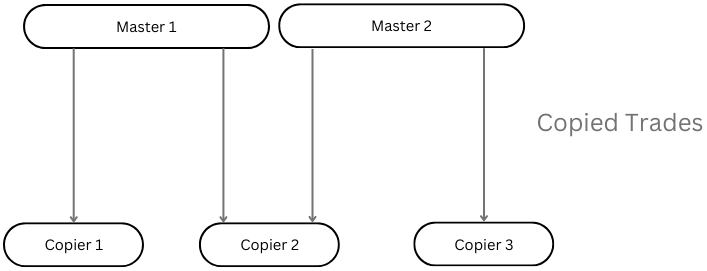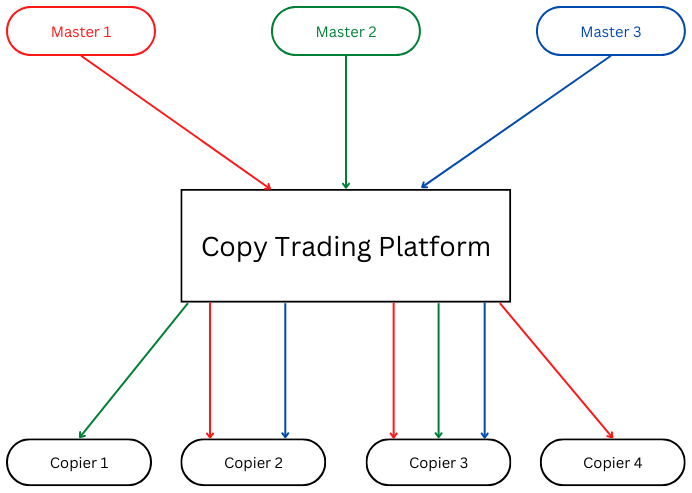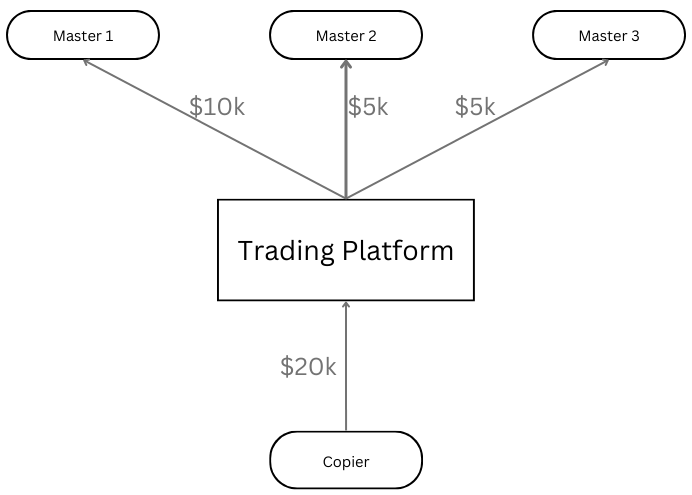Copy trading is a type of trading that appeared in the mid-to-late 2000s and has been growing in popularity since then. It is a very enticing option for newbie traders, though it also has its benefits for more experienced traders. The Forex market is especially attractive for copy traders because it is the biggest and the most liquid market globally. However, other markets, such as stocks and cryptocurrencies, can also be used for copy trading. This guide explains what copy trading is, what methods for copying trades exist, whether copy trading is regulated, and the advantages and risks associated with copy trading.
What is copy trading?
Copy trading is a subset of social trading. As the name suggests, it is a process that involves one trader copying transactions executed by another trader. Sometimes it is called a people-based form of investment as it allows one to invest in specific traders instead of assets.
The trader being copied is usually a more knowledgeable professional trader. They can be called copied trader, master trader, provider, leader, or signal provider. The copied trader either gets a flat fee from those who follow him or a percentage of profit from copying accounts. The trader who performs the copying process can be called a copying trader, social trader, copier, subscriber, or follower.
Initially, copy trading was performed manually. Copying traders were receiving signals from the signal provider and manually executing the same orders as the trader they were copying. Nowadays, when people are talking about copy trading they are more often than not talking about a completely automated process, in which copiers blindly follow other traders, making the same moves: opening positions, setting the stop-loss and profit-taking objectives, and closing positions.
Copy trading is especially appealing to inexperienced traders as it does not require any knowledge and skills with the financial market. It can also provide a learning opportunity as less experienced traders can gain knowledge and understanding of markets by watching how their more seasoned colleagues trade. The learning opportunity is usually very limited, though, as copy trading typically does not involve understanding specific strategies and reasons for transactions made by the master trader.
Copy trading can also have some benefits for more experienced traders. They can get trading ideas and gain more knowledge about trading by watching how the traders they are copying trade. Copy trading can also allow traders to diversify their portfolios by copying traders who are involved in the markets that copying traders have less or no experience. And copy trading can also be used as a sort of passive income to supplement regular trading, as copy trading typically requires very little time and effort.
The following pictures will visualize the basic concepts of copy trading. They should help you to understand better how it works.
This picture shows how copy trading works on the most basic level:
The picture shows that several traders can copy one master trader. Copiers 1 and 2 follow master 1, while master 2 is followed by copiers 2 and 3. As you can see, one trader can follow several master traders, not just one. In this example, copier 2 follows both master 1 and master 2.
This picture shows how a copy trading platform connects master traders and copying traders:
Masters send their transactions to the platform, and copiers can decide which master trader to follow. Each master in this picture is assigned a different color to differentiate their trades. As you can see, copier 1 follows master 2. Copier 2 follows masters 1 and 3. Copier 3 follows masters 1, 2, and 3. And copier 4 follows master 1.
This picture shows how one trader can allocate funds on their account to different master traders:
In this example, the copier transferred $20,000 to his account on the trading platform. He then allocated $10,000 to master 1, and $5,000 to masters 2 and 3 each.
Remember that when a master trader puts a portion of their funds into an asset, a copying trader puts an equal share from the allocated sum. For example, a master with a $100,000 account decides to buy EUR/USD, allocating 5%, or $5,000, to this transaction. The copier will also purchase EUR/USD but not for $5,000 but for 5% of the funds allocated to this master. If the copier allocates $10,000, he will spend $500 buying EUR/USD. If he allocates $5,000, he will spend $250.
History of copy trading
The history of copy trading is relatively recent. It can be traced back to the 90s when some traders were sending newsletters to their followers describing their strategies and trades. With the rise of the Internet in the 2000s, virtual trading rooms and chat rooms became the place where traders could discuss their plans and intentions. A professional trader could announce their order, and others could follow his example if they wanted to.
In the mid-to-late 2000s, the rise of automated (or algorithmic) trading led to the appearance of mirror trading and copy trading, though initially, the focus was on mirror trading. Tradency was one of the first to propose an automatic trading system in 2005 called Mirror Trader. Using this system, traders could post their strategies with the records showing the strategy’s performance while other traders could mirror on their accounts all transactions generated from that strategy.
Later, automatic system providers, such as eToro and Iconomi, went further, allowing one to link an account of one trader directly to an account of another trader without the need to submit a strategy. It allowed them to copy the moves of other traders entirely automatically.
In the 2010s, copy trading was rising in popularity, and plenty started to offer such a service. But the fallout from the financial crisis of 2008 and the increasing number of scammers prompted regulators to attempt to clear the market. The resulting tightening of regulations caused many brokers to shut down their copy trading services. The upside of this was the fact that the remaining copy trading service providers became more trustworthy, at least if they were registered with at least one of the major regulators.
Social trading, mirror trading, and copy trading: what is the difference?
Copy trading is often considered to be a branch of social trading. That said, sometimes copy trading, mirror trading, and social trading can be used interchangeably. The following list provides the most commonly used meaning of the terms:
- Social trading is the concept that involves traders sharing their ideas and plans over social media, forums, and other means. It does not include any automation of trading. Each trader should decide for themselves what strategy to use or devise their own strategy based on the ideas shared by other traders. It is the most time-consuming and effort-intensive type of trading on this list. It also often requires some level of knowledge, therefore, it is more suited for more experienced traders. That said, new traders can also benefit from learning from their more accomplished peers. While it takes more time and effort than other types of trading, the benefit of social trading is that it allows one to learn how to trade and helps to understand markets. It also gives a trader complete freedom to mix and match different strategies and trading styles, not requiring them to blindly follow other traders and their strategies.
- Mirror trading means mirroring the strategies of other traders. Instead of following any specific trader, traders using mirror trading mimic a strategy that could be created and used by any number of traders. Mirror trading can be performed by executing trades manually according to the chosen strategy. Or it can be automated by using robots and expert advisors. Mirror trading typically consumes less time and requires less effort than social trading, especially if it is automated. The additional benefit of this method is that strategies based on technical analysis can be used for any number of assets. This type of trading provides less flexibility than social trading, as you are expected to follow the strategy blindly. The only choice you have is what strategy to use and when to stop using it if you do not like it.
- Copy trading is a process of copying the trades of another trader. Instead of mirroring a strategy, you copy every action of the trader you have chosen to follow. The copying can be done manually by making the same trades as the selected trader. But modern providers of copy trading services allow the complete automation of the process. In this case, you need only to choose which trader (or traders) to follow and what percentage of the capital on your account to allocate to that trader. Afterward, copy trading is entirely passive. The obvious benefit is that copy trading frees up your time for other activities and allows you to benefit from the expertise of more knowledgeable traders. But the learning potential is limited. And you also give up the freedom in your trading decisions, although some platforms allow you to set your risk parameters for yourself or even to choose which trades to perform.
Copy trading methods
There are several different approaches to copy trading:
- Automated. Use the copy trading platform to choose a trader to follow, set your risk parameters if the platform allows, and sit back and wait for the results. It is the most hassle-free way of copy trading.
- Manual. You should decide for yourself whether to execute or not any given trade made by the trader you have chosen to follow. And then, you need to manually execute the transaction if you decide to do so, just as you would do if you were trading for yourself. This method takes more time and effort, and market conditions can change between the time when the followed trader executed their trade and the time you got the notification and made your own trade. But on the positive side, this method gives you more liberty and allows you to avoid trades that you do not like.
- Coaching. It is similar to manual copy trading, but you pay not only for copying another trader’s moves but also for explaining why those moves were made. This method is especially good for completely new traders as it allows them to learn trading directly from an experienced trader. Needless to say, this method is almost always more expensive than other methods. And it can be hard to find a good teacher who knows what they are doing.
How does it work?
The exact steps to start copy trading vary depending on your chosen copy trading platform. But most commonly, copy trading involves the following steps:
- First thing first, you need to find a suitable platform that offers the copy trading service. Try to choose among popular copy trading providers that have a good reputation and a long history and are preferably registered with at least one of the major regulators.
- Before starting copy trading for real, it is a good idea first to test the platform using a demo account.
- If you are satisfied with the results on the demo account, you can start copy trading in earnest. Find a trader to copy, though it is better to follow several traders. Thoroughly analyze the trader’s track record before following them. A good trader to follow should be active, have consistent results, have a large number of followers, and trade with the platform for at least several months. Be careful that a popular trader is not always a good one. Double-check their results, especially if they look too good to be true. It is a very good idea to diversify your portfolio. Suppose you follow one trader who specializes in the Forex market. In that case, another trader you choose to follow may be involved in commodities or stocks. Or choose traders that operate on different time frames. If one signal provider of your choice is a day trader, another can be a swing trader.
- The next step is to decide how much capital you want to allocate to each trader you follow. Start small. You can always add more funds to the trader if you are satisfied with their performance.
- Set risk parameters if the platform allows it.
- Connect your account to the trader of your choice and sit back, waiting for results. The platform will then automatically copy all the selected traders’ moves into your trading account.
- Adjust the funds you allocated to the trader based on their performance, adding more funds if you like their trading results.
Regulations
Copy trading is perfectly legal in most countries. In general, there are no regulations that are specific for copy trading. But you should be aware that laws and regulations differ from country to country, and you should check the regulations in your country before starting copy trading. It is especially important if you allow other traders to copy your transactions as such activity can be considered investment advice or similar financial service, and it can require appropriate authorization. The additional danger for copying traders is that the country where the trader you are copying resides can have a different set of regulations than your country. Some copy trading platforms can account for that, preventing transactions that go against regulations in your country. But, to be safe, it is better to copy traders who reside in your country or, at the very least, in a country with similar laws. Otherwise, you will be responsible for the illegal transaction even if it was made completely automatically.
The European Securities and Market Authority considers copy trading and mirror trading to fall under the MiFID Directive (according to answer 9 in the Q&A regarding MiFID) and has a different approach to copy trading, depending on whether it is automated or not. Automated copy trading is considered to be a portfolio management service and requires the appropriate authorization from the service provider. In contrast, manual copy trading is not considered to be portfolio management. Still, can fall within other financial services categories, such as investment advice or reception and transmission of orders.
UK’s Financial Conduct Authority has the same approach as the ESMA to copy trading.
The United States has stricter regulations than most countries. In particular, the Dodd-Frank Act of 2010 has two rules that are relevant to copy traders: no hedging allowed (you cannot have both a short and a long position in the same asset at the same time) and FIFO (First In, First Out — positions in the same asset should be liquidated in the same order they were opened). Because of the additional regulations, it is better for US traders to copy only other US traders.
Advantages and disadvantages
Copy trading can have significant benefits for traders, especially inexperienced ones. But at the same time, it also has disadvantages and risks. You need to carefully consider both pros and cons before deciding whether you want to participate in copy trading.
Advantages
Copy trading has many advantages, especially for traders who just started their trading career or want to dabble in trading without making it their full-time job. However, more experienced traders can benefit from it as well. Here are some of the advantages copy trading has:
- Accessibility. Copy trading requires no prior knowledge about trading, making it great for novice traders.
- Access to another trader’s expertise. Copy trading allows you to benefit from the expertise and knowledge of someone with more market experience than you.
- Learning from more experienced traders. By watching more expert traders, you can learn about markets and expand your knowledge.
- Diversification of portfolio. With a wide range of traders providing signals for copy trading, you can gain access to many markets and trading styles. It makes copy trading useful even if you are a seasoned trader, as it allows you to access markets you have less or no knowledge of.
- Copy trading helps you to free up time. As copy trading can be completely automated, you can participate even if you have a day job. Or you can use your free time to learn more about markets. You can also dedicate it to your hobbies or social life.
- It removes emotions from trading. It can be hard to avoid emotions when you are risking your own money, and emotions can lead to irrational and suboptimal trades. Copy trading removes this issue, as automated trading makes it impossible for your emotions to affect results.
- Signal providers can earn additional money from trades. Expert traders can benefit from copy trading in another way — being a signal provider. You can multiply your profits by allowing other traders to copy your trades.
Risks and disadvantages
However good copy trading can be, it also carries some disadvantages and risks you should be aware of. To limit risk, you need to diversify your portfolio (do not put all eggs in one basket), limit the amount of funds you allocate to any specific trader, and set up risk parameters on the platform according to your preferences if the copy trading platform allows it. Consider the following points before deciding whether you want to copy other traders:
- Less control. Copy trading (especially automated) removes control over your funds from your hands as you just blindly follow other traders.
- Limited learning potential. While you can learn some lessons by watching more experienced traders, the learning potential is rather limited. Unless you already know the markets, it can be hard to tell why the trader you are copying does what they do and why their trades are winning or losing. Nothing beats your own experience when it comes to learning how to trade, and copy trading simply does not allow this.
- Market risk. Markets are hard to predict, and the trader who was winning yesterday can have a losing streak tomorrow. Remember that past performance does not indicate future performance.
- Liquidity risk. Sometimes, your trade cannot be executed at the same price point as the trade you are copying or at all. That can happen because of the delay between the original transaction and the copying transaction market conditions can change before your trade can be executed. And you cannot sell an asset if nobody is willing to buy it or buy an asset if nobody is selling it. That is a risk present mostly if you are trading illiquid assets such as exotic currency pairs or low-cap stocks. To avoid this risk, you should copy trader participating in popular markets. For example, it is highly unlikely that you will be unable to find a buyer or a seller for EUR/USD.
- Systematic risk. It includes geopolitical events and other rare or unique events that are hard or impossible to predict, but they still can affect markets. For example, when the Swiss National Bank dropped the euro-franc peg back in 2015, the EUR/CHF currency pair dropped sharply. You should be aware that such events can result in losses even for an otherwise profitable trader.
- Copy trading can be expensive. Copy trading is often more expensive than regular trading. Sometimes, signal providers require a large upfront fee. Or they can take a commission for every transaction you copy. You should also be aware of your broker’s spreads which can eat up your profits. While it is usually recommended to follow active traders, you should be aware that following a trader who makes frequent trades can pile up commissions.
Bottom line
Copy trading is one of the easiest ways to dabble in trading as it involves just copying the actions of other, more skilled, traders. It is especially useful for novice traders as it allows them to participate in markets without prior knowledge as well as to learn from professional traders. More experienced traders can also benefit from copy trading, watching and learning from their peers with more knowledge and experience, as well as adding a passive income to the profits from their regular trades. But as with any strategy, copy trading has its own downsides and risks. Ultimately, you give up control over your money to someone you do not know. You also will not learn much just by watching other people trade without trying to trade for yourself. In the end, if you are serious about trading, copy trading should be nothing more than just a starting point.







